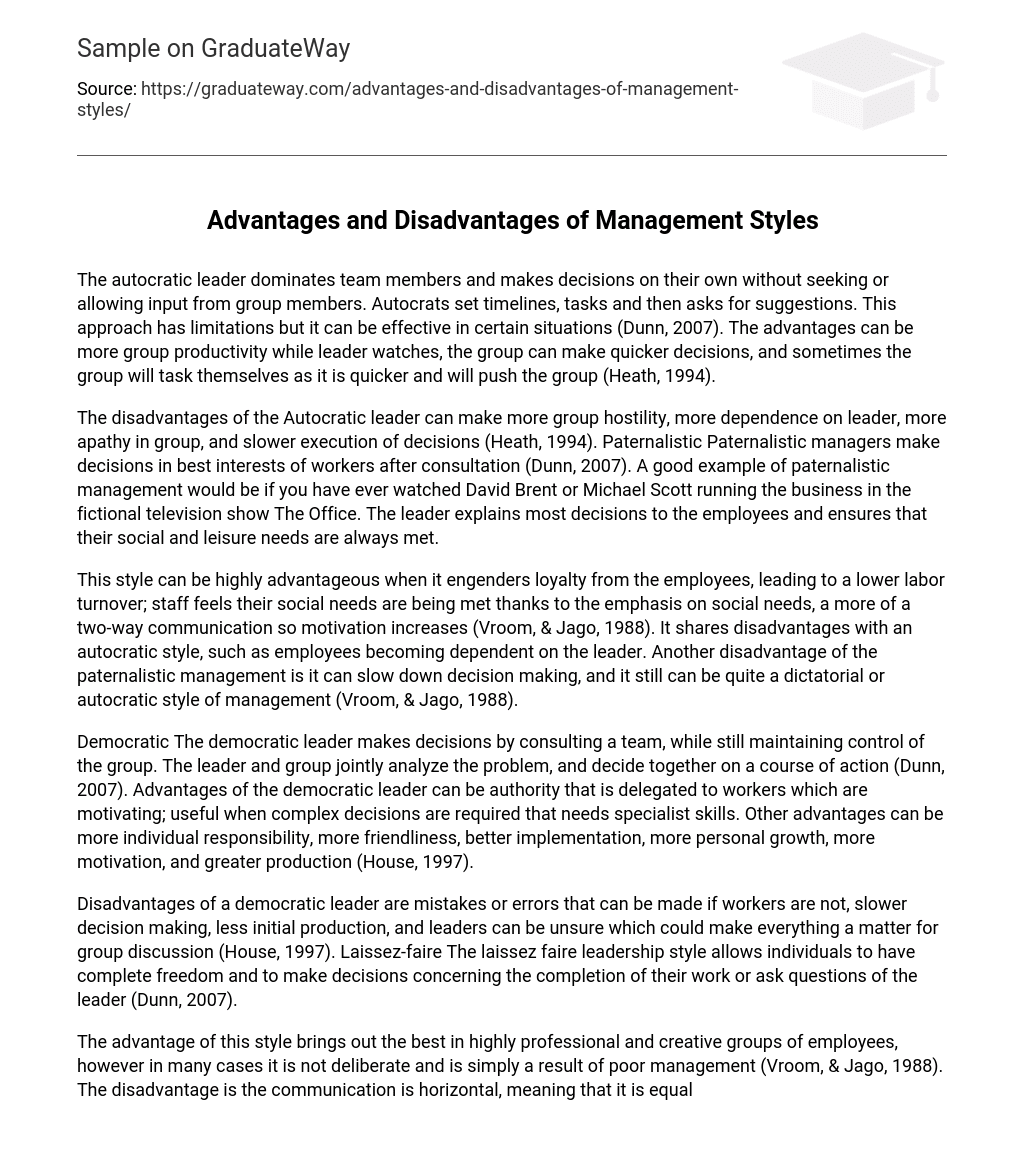The autocratic leader is dominant and makes decisions without input from group members. They set timelines and tasks but may ask for suggestions. This approach, although it has limitations, can be effective in certain situations (Dunn, 2007). Advantages include increased group productivity while the leader oversees, faster decision-making by the group, and the group taking on tasks themselves to increase efficiency and motivation (Heath, 1994).
The Autocratic leader has several disadvantages, including increased group hostility, greater dependence on the leader, decreased motivation within the group, and slower decision-making (Heath, 1994). On the other hand, Paternalistic managers make decisions that are in the best interests of the workers after consulting with them (Dunn, 2007). A prime example of paternalistic management can be observed in characters like David Brent or Michael Scott from the fictional television show The Office. These leaders often explain their decisions to their employees and make sure to fulfill their social and leisure needs.
The paternalistic management style can have many advantages. One of these advantages is that it can foster employee loyalty, resulting in a lower turnover rate. Additionally, this style prioritizes meeting the social needs of employees, which helps to increase motivation through two-way communication (Vroom & Jago, 1988). However, there are also some disadvantages to this style. Employees may become dependent on the leader, similar to an autocratic style. Moreover, decision-making processes may be slowed down and the style can still exhibit dictatorial or autocratic tendencies (Vroom & Jago, 1988).
The democratic leader values the input of their team and maintains control of the group while making decisions. They collaborate with the group to analyze problems and determine the best course of action (Dunn, 2007). This leadership style offers several advantages, including the delegation of authority to workers, which can be motivating. It is particularly useful in situations that require complex decisions and specialized skills. Additionally, it promotes individual responsibility, friendliness, efficient implementation, personal growth, motivation, and increased production (House, 1997).
Disadvantages of a democratic leader include the potential for mistakes or errors if workers are not careful, slower decision making, less initial production, and uncertainty from leaders that may result in everything becoming a matter for group discussion (House, 1997). On the other hand, the laissez faire leadership style permits individuals to have complete freedom to make decisions about their work or seek guidance from the leader (Dunn, 2007).
The advantage of this style emphasizes the strengths of highly professional and creative employee groups. However, it is often unintentional and a result of ineffective management (Vroom, & Jago, 1988). The disadvantage is that communication is horizontal, meaning it flows equally in both directions. However, compared to other styles, there is very limited communication. As a result, there is a lack of staff focus and direction, leading to dissatisfaction and a negative company image (Vroom, & Jago, 1988). In the Contingency style of management, it is assumed that there is no simple one right way.
Contingency takes a broader view that includes contingent factors about leader capability and other variables within the situation (Smith, 1984). Advantages include one-way communication in the what, how, why, when, and where to do the task; shared decision making about aspects; leader stays involved to monitor progress (Barney, 1985). A disadvantage of this style is that leaders who are very effective at one place and time may become unsuccessful either when transplanted to another situation or when the factors around them change. This helps to explain how some leaders who seem for a while to have the ‘Midas touch’ suddenly appear o go off the boil and make very unsuccessful decisions (Barney, 1985). The best management style is situational but it goes beyond motivation. I’ve had nurses who need only a broad outline of the objective we are trying to reach; I can manage them with little direction. Others need more supervision and I’ve managed some people who require micro management. I think the best managers strike a balance between the needs of the employee and the managers own tendencies. The best managers view their role as not only getting the job done but also developing their employees and treating them with respect.
References
Barney, J. B. (1985,). Dimensions of Informal Social Network Structure: Toward a Contingency Theory of Informal Relations in Organizations. Social Networks, 7(), 1-46. Retrieved from http://www. rpi. edu/dept/advising/management_styles. htm
Dunn, R. T. (2007). Leadership. In Haimanns (Ed.), Healthcare Management (pp. 434-443).
Heath, L. R. (1994). Management of corporate communication. Hillsdale: Lawrence Erlbaum.
Hersey, P., & Blanchard, K. H. (1993). Management of Organizational Behavior: Utilizing human resources (6th Ed.). Englewood Cliffs, NJ: Prentice Hall.
House, R. (1997). Path-goal theory of Leadership: Lessons, legacy, and a reformulated theory. Leadership Quarterly, 7, 323-352. Retrieved from http://en.wikipedia.org/wiki/management_styles
Smith, M. J. (1984). Contingency rules theory, context, and compliance behaviors. Human Communication Research, 10, 489-512. Retrieved from http://www.rpi.edu/dept/advising/free_enterprise/business_structures/management_styles.htm
Vroom, V. H., & Jago, A. G. (1988). The new leadership: Managing participation in organizations. Englewood Cliffs, NJ: Prentice Hall.





